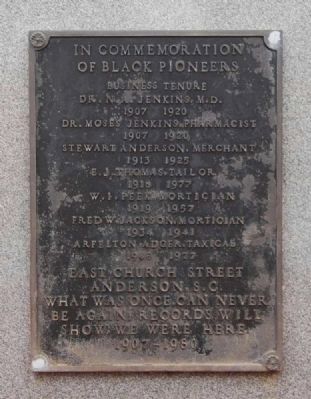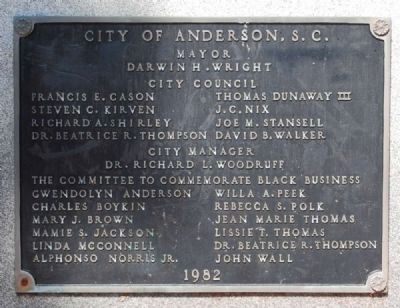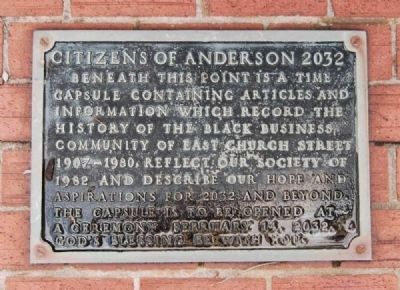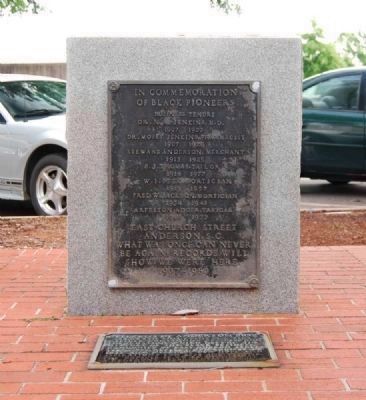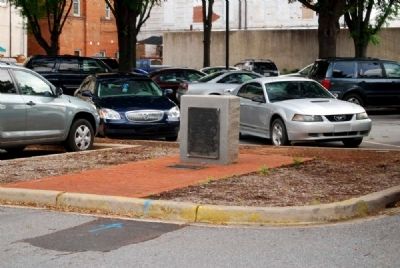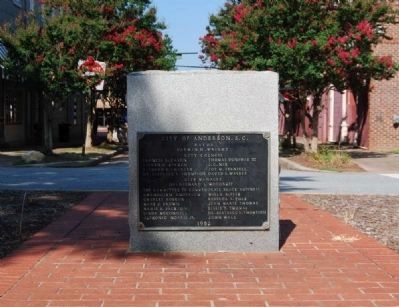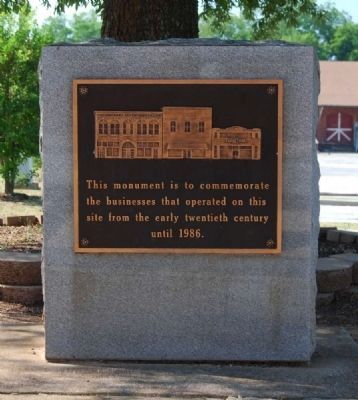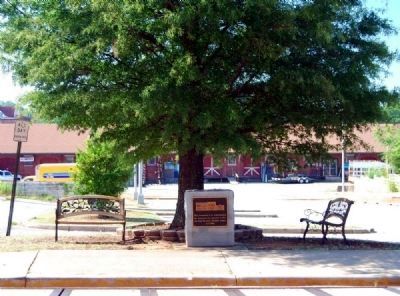Anderson in Anderson County, South Carolina — The American South (South Atlantic)
In Commemoration of Black Pioneers
[Front]:
Dr. N.H. Jenkins, M.D.
1907 1920
Dr. Moses Jenkins, Pharmacist
1907 1920
Stewart Anderson, Merchant
1913 1925
E.J. Thomas, Tailor
1918 1977
W.I. Peek, Mortician
1919 1941
Arfelton Adger, Taxicab
1946 1977
East Church Street
Anderson S.C.
What Was Once Can Never
Be Again; Records Will
Show We Were Here
1907-1980
[Reverse]:
Mayor
Darwin H. Wright
City Council
Francis E. Cason, Thomas Dunaway III
Steven C. Kirven, J.C. Nix
Richard A. Shirley, Joe M. Stansell
Dr. Beatrice R. Thompson, David B. Walker
City Manager
Dr. Richard Woodruff
The Committee to Commemorate Black Businesses
Gwendolyn Anderson, Willa A. Peek
Charles Boykin, Rebecca S. Polk
Mary J. Brown, Jean Marie Thomas
Mamie S. Jackson, Lissie T. Thomas
Linda McConnell, Dr. Beatrice R. Thompson
Alphonso Norris, Jr., John Wall
[Time Capsule]
capsule containing articles and
information which record the
history of the black business
community of East Church Street
1907-1980, reflect our society of
1982 and describe our hope and
aspirations for 2032 and beyond.
The capsule is to be opened at
a ceremony February 14, 2032.
God's blessing be with you.
Erected 1982 by Committee to Commemorate Black Businesses.
Topics and series. This historical marker is listed in these topic lists: African Americans • Industry & Commerce. In addition, it is included in the Time Capsules series list. A significant historical date for this entry is February 14, 1971.
Location. 34° 30.133′ N, 82° 38.95′ W. Marker is in Anderson, South Carolina, in Anderson County. Marker is at the intersection of East Church Street and South Main Street (South Carolina Highway 28) on East Church Street. An additional marker (shown below) dedicated to the African American businesses of Church Street is located near the intersection of West Church Street and South Murray Avenue (U.S. Highway 29). Touch for map. Marker is in this post office area: Greenville SC 29601, United States of America. Touch for directions.
Other nearby markers. At least 10 other markers are within walking distance of this marker. More Than Food: Savoring the Flavor of Dignity (here, next to this marker); The Church Street Heritage Plaza (here, next to this marker); Beyond Commerce: Building a Legacy of Hard Work (a few steps from this marker); After Dark: Seeking Harmony in Music and Culture (a few steps from this marker); Bank of Anderson Building - ca. 1891 (within shouting distance of this marker); Masonic Temple -- 1889 (within shouting distance of this marker); Sullivan Hardware Co. -- 1875 (about 300 feet away, measured in a direct line); The Four Way Test (about 400 feet away); Anderson County Law Enforcement Officers Memorial (about 500 feet away); G. Ross Anderson Jr. Federal Building and United States Courthouse (about 500 feet away). Touch for a list and map of all markers in Anderson.
Also see . . . Church Street an important part of Anderson’s history. I was happy to read that recognition is forthcoming for the business area that was located on East Church Street. (Submitted on June 13, 2009, by Brian Scott of Anderson, South Carolina.)
Additional commentary.
1. Honoring the memory of East Church Street
Anderson Independent-Mail
By Doug Staley
April 3, 2007
Napoleon Johnson remembers the days when the crowds would line up outside the Friendly Barber Shop for 75-cent haircuts.
Back then, the shop was located right in the heart of the city’s black business district at 112 E. Church St.
“We had people from Seneca, Clemson, Honea Path, Hartwell and Townville,” said Mr. Johnson, who moved to Anderson from Chesterfield County in 1960 to work at the shop. “It was like a city within a city. Everybody made a decent living up there. It was the only place the blacks had to hang out.”
Today, Mr. Johnson, who assumed ownership of the shop about six years ago, and Johnny Williford, owner of the Anderson Tailor Shop, are the only surviving members of the Church Street fraternity. Most of the buildings associated with the district were razed in the early 1980s for the construction of a downtown parking lot.
“We were like a family,” said Mr. Johnson, sitting in the shop now located a couple of blocks away on West Church Street. “I thank God that I’m still here. As long as I’m in my right mind and in good health, I’m going to continue.”
Besides the barber and tailor shops, the only visible reminder of the business community, which ran between Main and McDuffie streets, are two plaques in the parking lot.
But that soon could change.
The city of Anderson is moving ahead with a project to commemorate the black entrepreneurial district on East Church Street. Last fall, the city received a $19,250
matching grant from South Carolina Heritage Corridor Association for the project, according to Downtown Manager Debra Credeur. The city is expected to provide $19,000 in matching funds.
The final price tag could be less than $40,000, however, depending on what shape the final project takes, Assistant City Manager Linda McConnell said. The initial phase will involve acquiring oral histories by filming interviews with surviving business owners and relatives. Future phases could include adding sidewalk plaques, a wall of fame or artwork, according to officials.
“We really see this as the first phase of a larger project that could have a lot of neat components,” Ms. McConnell said. “We have an historic downtown, so certainly part of our character and charm is what we’re out to not just preserve but make it one of the elements that attracts people.”
In addition to preserving history, Ms. Credeur said the project could serve as an attraction for downtown visitors. She said the city is considering making a CD of the oral histories and printing brochures that could be used for a self-guided tour.
“It will give people something additional to do besides shopping and eating,” she said.
City Council member Beatrice Thompson, whose husband, Harry, operated a soda shop with R.A. McGee in the district, believes the contributions of the Church Street business owners deserve more recognition.
Completing the filming for the oral histories is a priority, Mrs. Thompson said, as there are only a handful of surviving business owners and relatives.
“This black business district was too important to be commemorated with just a plaque,” she said. “There’s a rich culture we need to remember in that area. I felt it was too important a history not to be recognized ... we’re excited about it. We hope to accomplish a lot.”
She and a group that includes Patrick Flack, John Weir, Alphonso Norris, Harry Thompson, Vermelle Williams and Mary Francis Calhoun, started meeting about five years ago to discuss ways to honor the district’s memory.
Ms. Thompson also served on a committee that compiled the book, “The Legacy of Black Pioneers: 1907-1980 East Church Street,” in the early 1980s. She said the community included hat and shoe shops, drug and variety stores, dentists, department stores and a theater.
“At that time, black people could not go to a white restaurant and be served,” Ms. Thompson said. “Black business owners developed restaurants where you could go and be served there with pride. They had a great impact on downtown.”
— Submitted June 13, 2009, by Brian Scott of Anderson, South Carolina.
2. Longtime Anderson Tailor Dies: Johnny Williford One of Last Spokesmen for Historic Black Businesses
Anderson Independent-Mail
By Samantha Harris
Monday, February 25, 2008
ANDERSON — Johnny Williford, a local tailor whose business was the last piece of the historic Church Street black business district in downtown Anderson, will be laid to rest today. Mr. Williford 87, of 1204 Stephens St., passed away Friday at his home.
He operated Anderson Tailor Shop, one of the many black-owned businesses that thrived in the black business district on and around Church Street before integration. Most of the other businesses were torn down in 1980 to make a parking lot. Mr. Williford is one of the black business owners who will be featured in “Trading Church Street,” an upcoming documentary film, which will tell the stories of the black business district.
Those who knew Mr. Williford described him Monday as a man of strong faith, strict work ethic and sincere love for his family.
“He was a good fellow, a very good tailor,” Charles Richardson, a former customer, said. “We patronized him when he had his business on Church Street for years and years. He would help you in any way that he could. He was just as
nice as he could be.”
Napoleon Johnson, owner of Friendly Barber Shop, remembers Mr. Williford being in business when he Mr. Johnson moved to town in 1960.
“He was a good husband and family man,” Mr. Johnson said. “He worked hard all his life, and hardly took any time off to do anything. He loved his job, he loved the Lord and he wanted to do what was right. He was determined to send all his kids to college.”
Mr. Williford and his wife, Lois, had five children. Funeral services for Mr. Williford will be held at 11 a.m. today in the Ollie Robinson Brown Memorial Chapel of Marcus D. Brown Funeral Home. Visitation will begin at 10 a.m.
— Submitted July 28, 2009, by Brian Scott of Anderson, South Carolina.
3. Taking pride in Church Street
Anderson Independent-Mail
By Samantha Harris
Saturday, March 1, 2008
Thursday afternoon I was sitting with a crowd of people in Anderson City Hall. We were watching the premiere of “Trading Church Street,” a documentary film about the black business district that thrived decades ago in downtown Anderson.
Back then (from 1900 to 1980), Church Street was a block along Main Street, and it was full of businesses owned and operated by black people. These restaurants, doctor’s offices, mortuaries, salons and other establishments gave black customers a place to go during the days of segregation when white-owned businesses would not serve them.
Black people interviewed in the film recalled being forced to eat from the street at the back door of restaurants downtown. In most stores, they were treated as second-class citizens, steered toward “Colored only” drinking fountains and not allowed to try on clothes. But in the black business district on Church Street, a black man could walk into a restaurant with his head held high, go right up to the counter and sit there without being harassed.
I heard the pride in the interviewees’ voices as they talked about these businesses and how their owners were revered role models in the black community. With integration came the demise of most of these businesses. The city tore down the buildings and created a parking lot in 1980.
I looked around the room during the film and something struck me. The film viewers were evenly divided. Black people were sitting on the left side of the room, and the right side was full of whites.
What did that mean? I wasn’t sure.
We were in the room together, something that never would have happened had the days of segregation continued. But the people who had worked, shopped and celebrated together there on Church Street have an obvious bond that will never fade. And a downtown Anderson where dozens of businesses are black-owned and many of the community’s wealthiest entrepreneurs are minorities obviously was a foreign concept to many in the room, including me.
I am glad segregation ended. But I would love to go back in time and walk up and down Church Street in the 1950s, soaking up its sights, sounds and smells. When I returned, it would be wonderful if what I saw downtown was a mixture of businesses owned by people of several races, and everyone was patronizing each other’s establishments. It was a pleasure to see the film, especially during Black History Month.
As I was leaving City Hall, a man in a fancy car pulled up beside me looking for Sullivan’s Metropolitan Grill downtown.
“It’s three blocks up,” I said. “It’s just before Church Street.”
If he ever sees “Trading Church Street,” he’ll know why my smile was so wide.
— Submitted July 28, 2009, by Brian Scott of Anderson, South Carolina.
Credits. This page was last revised on October 14, 2020. It was originally submitted on June 13, 2009, by Brian Scott of Anderson, South Carolina. This page has been viewed 2,438 times since then and 73 times this year. Last updated on June 13, 2009, by Richard E. Miller of Oxon Hill, Maryland. Photos: 1. submitted on June 13, 2009, by Brian Scott of Anderson, South Carolina. 2. submitted on July 28, 2009, by Brian Scott of Anderson, South Carolina. 3, 4, 5. submitted on June 13, 2009, by Brian Scott of Anderson, South Carolina. 6, 7, 8. submitted on July 28, 2009, by Brian Scott of Anderson, South Carolina. • Syd Whittle was the editor who published this page.
